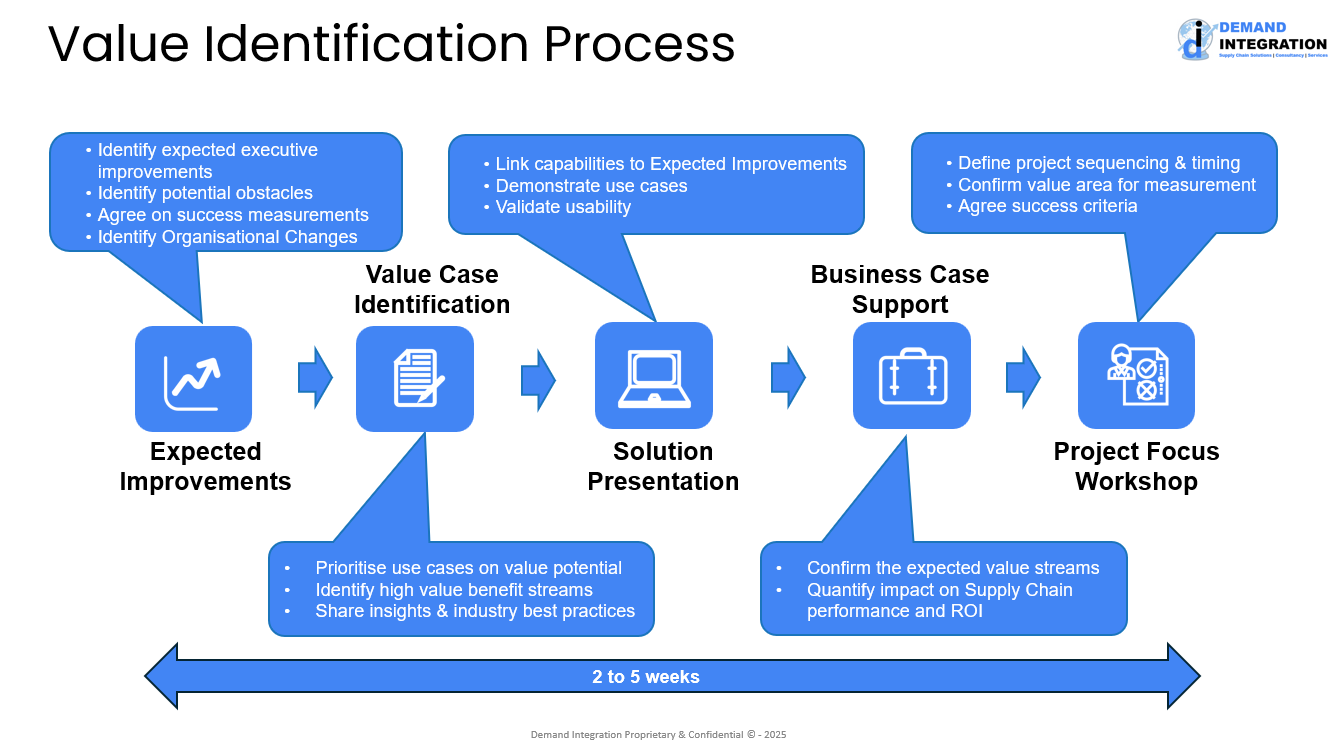The DIL Value Identification Process
Every project needs to clearly show its costs and the benefits it will bring - and Supply Chain Planning is no different.
If you want the green light for investing in Supply Chain Planning (SCP) tools, you need to highlight real benefits, like improved forecast accuracy, smarter planning, and better efficiency.
That’s where the DIL Value Identification Process (“VIP”) comes in. VIP helps you quickly identify the 'size of the prize', where you’ll get the most value, set clear goals, and measure progress with user friendly KPIs.
With VIP, you can confidently demonstrate the return on your investment and easily update your approach as your supply chain or business needs change.

What's involved?
Expected Improvement Meeting
This meeting is an important step, giving your senior team a clear, open look at both the challenges and the benefits ahead.
Here’s what to expect:
- Your senior executives and supply chain leaders will be involved
- You’ll highlight the improvements your leadership team is looking for
- Any challenges that could affect success will be discussed
- We’ll agree on the KPIs and supply chain metrics needed to track progress
- You’ll identify any changes your organisation might need to make these improvements happen
Who should join: Senior Management, Supply Chain leaders, Project stakeholders, and anyone involved with or interested in supply chain planning.
Duration: 90 to 120 minutes
Value Case Identification
After the Expected Improvements meeting, our DIL team will get to work building Value Cases for your project.
Here’s what you can look forward to:
- We’ll shine a light on the Use Cases that bring you the most value—both financial and non-financial.
- We’ll highlight the key benefit streams that help fund your project and set up KPIs.
- You’ll hear tips and success stories from similar projects we’ve worked on.
- Before the Solution Presentation, you’ll have a chance to suggest any changes or share new ideas.
Who should attend: Your Project Sponsor or team lead
Duration: 30 to 60 minutes
Solution Presentation
This is where we show you what’s possible and how the right solution can make a real difference for your business.
We’ll walk you through:
- How the software delivers the improvements your senior team is looking for
- The agreed Use Cases, so you can see if the solution is the right fit
- How easy the solution is to use in your everyday work
Who's involved: Your selection team and Users
Duration: 90 to 150 minutes
Business Case Support
With a mutual NDA in place, we’ll ask you a few simple questions about your business—like forecast accuracy, inventory levels, and manufacturing timelines. Using our experience, input from leading software vendors, and industry benchmarks, we’ll put together a clear and helpful business case for your project.
Here’s what you can look forward to:
- We’ll show exactly where the new system will add value for you
- You’ll get an easy-to-understand overview of how your supply chain could improve
- We’ll walk you through a straightforward ROI calculation, covering costs, savings, and when you can expect to break even
- We’ll go over the numbers together, and you can ask questions or suggest changes so everything matches your real-world needs
Who's involved from your side: Project Sponsor
Duration: 30 to 60 minutes
Project Focus Workshop
We know surprises aren’t welcome during a project, so before any contracts are signed, we’ll walk you through exactly what to expect.
In this session, we’ll cover:
- Project roles—who does what, from both our side and yours
- Responsibilities for everyone on the project team
- Timelines for each stage of delivery
Who should attend: Your project team and sponsor
Duration: 45 to 75 minutes
What's in it for you?
Good Question ....
With the VIP, you get valuable insights at no cost - just a few hours of your time. You’ll see if a new Supply Chain Planning solution is right for your business, what benefits you can expect, and how to measure your results.
There’s no pressure to pick DIL afterwards. You’re welcome to use what you learn to explore other options and make the best choice for your team.
